Cadmans Neck “The Great Show of 1893 Fun for the millions”
Posted on July 28, 2025 by Jenny ONeill
By Jenny O’Neill
The following article summarizes a presentation given to Cadmans Neck Improvement Association in July 2025.
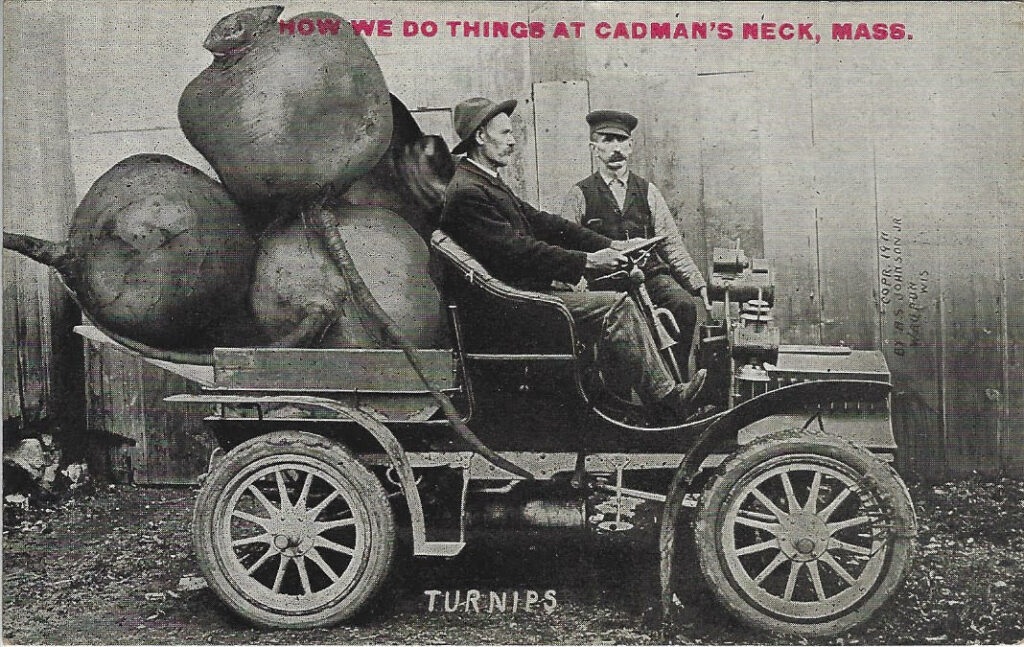
Many years ago, I dipped my toe into Cadman’s Neck history, and presented a program about the camp meetings. It was my first introduction to the story of this community. I simply couldn’t believe what I found. At the time of my research, sources were somewhat limited, including some documents/accounts in the collection of the Westport Historical Society, as well as the New Bedford newspapers via microfilm! This research is shared at Westport’s Tented City https://wpthistory.org/2009/01/cadmans_neck_we/. Since that initial research, so much more information has become available through the digitization of Fall River newspapers, available at the Fall River Public Library website.
More information has been discovered locally too:
The journal of Frederick Allen
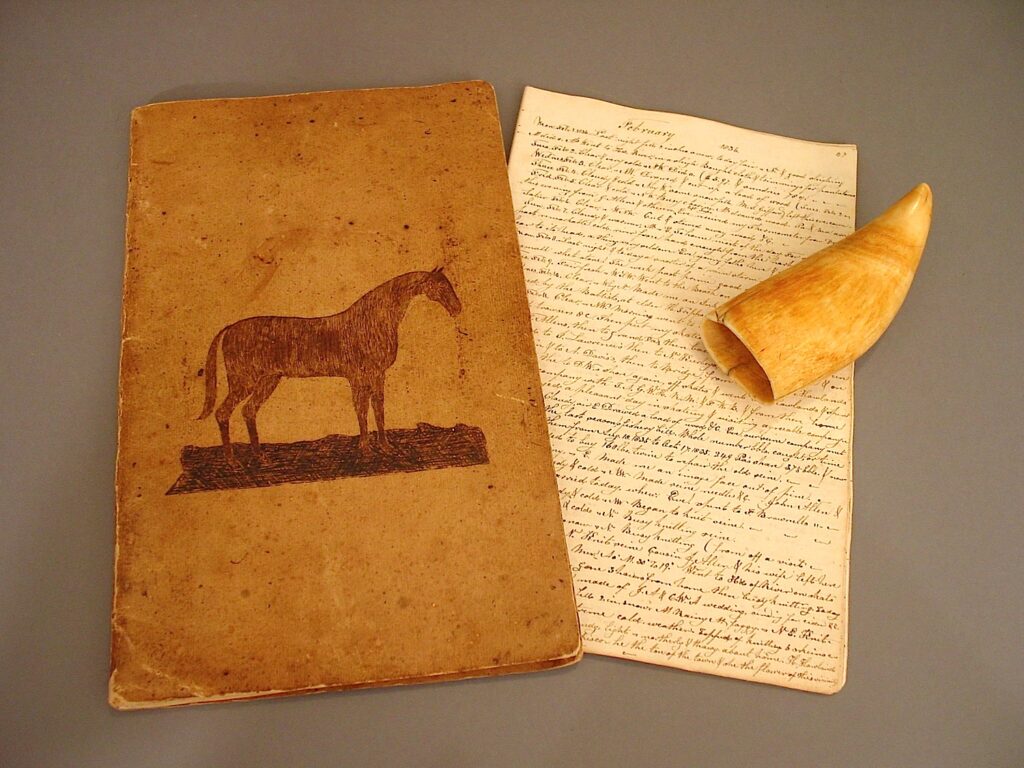
Frederick was the father of Cortez Allen, an important Cadmans Neck resident. The journal covers the years 1833 -1838. Frederick Allen is a young man of 23 years, working on the farm of his father, Major Allen.
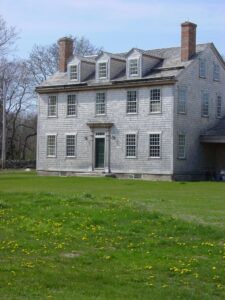
Frederick Allen’s childhood home, reassembled and relocated to Main Road
Frederick grew up in a house once located on present day Buzzards Bay Brewery property. In 2012 this house was carefully dismantled and relocated to Main Road in Westport where it was reassembled by Dora & Tripp Milliken.
With the help of volunteers, the journal was transcribed and can be accessed at https://wpthistory.org/explore-2/journal-of-frederick-allen/. Much of the journal consists of daily records of farming activities such as the weather and wind direction. The second half is an account of Frederick’s voyage on a whaling ship. A year after his return, Frederick married Hannah Brownell. They had three children: Cortez, Charlotte, and Mollie.
The journal doesn’t provide a great deal of information about Cadmans Neck, but it does contain references to sheep grazing on Great Island and on Cadmans Neck.
Another recently discovered resource is through the Westport Grange. A project to document the history of the Grange revealed a small handwritten account book kept by Cortez Allen detailing the formation of the Dartmouth Westport Agricultural Fair Association. Additional accounts are in the Dartmouth Grange archives. The fair was organized jointly by the Westport and Dartmouth grange and was held here at Cadmans Neck in 1893 and 1894. One person – Cortez Allen — looms large in the organization of this event, and more broadly, in the history of Cadmans Neck, so we will focus on him first before delving into the details of the fair.
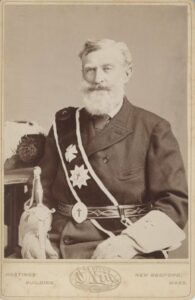
Who was Cortez Allen?
As a young man, Cortez went on a whaling voyage on the Pamelia. He served two years in the Massachusetts House of Representatives. Cortez was involved in many aspects of town government, serving on the school committee, as selectman, and as town treasurer.
He was first master of the Westport Grange and a member of Noquochoke Lodge, and charter member of the Cortez Allen Chapter 161 Order of the Eastern Star.
He married Lydia Francis, with whom he had three children: Irving, Edson, and Agnes.
He died at the age of 87 in 1926 and is buried in Beech Grove Cemetery with his parents and his wife, Lydia.
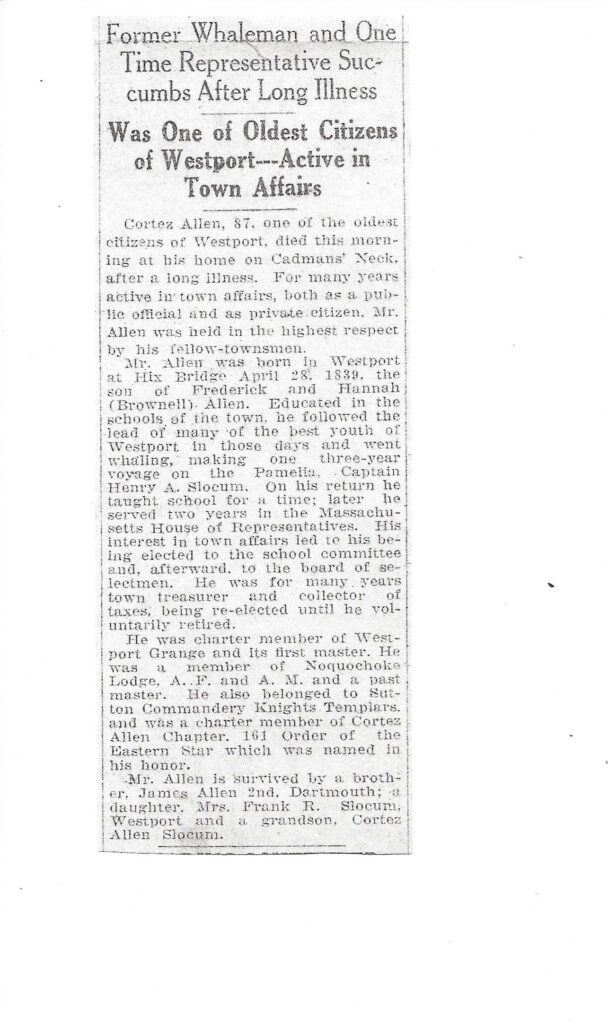
Cortez is a notably unusual name for this area. It does not seem to have a familial connection. Possibly, Frederick Allen came across this name during his whaling voyage, or perhaps he was influenced by this publication on Hernan Cortez:
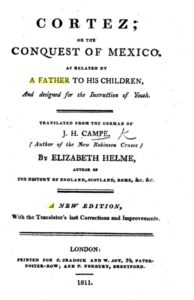
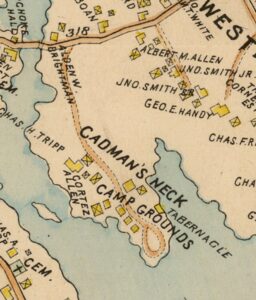
The Allen family had owned portions of Cadmans Neck since the 1820s. (See research by Richard Gifford). Piece by piece, the family consolidated their landholdings. There are no houses shown at Cadmans Neck on the maps of 1851, 1858, 1871, but, by 1895, Cortez Allen had built his house and was living here.
Cortez Alllen is at the center of all events at Cadmans Neck, closely involved with the camp meetings and the agricultural fair. He both organizes these events and likely profits from them.
The Dartmouth and Westport Patrons Agricultural Fair
A detailed picture of the fair emerges from the meticulously kept accounts by Cortez Allen, the lengthy articles in the Fall River newspapers, and fair booklets in the collection of the Westport Historical Society.
Formation of the Dartmouth and Westport Patrons Agricultural Association:
1893
At a meeting at the residence of John Howland (local photographer), they elected Henry Plummer president and Cortez Allen secretary. Tabitha Howland and Gracie Tripp were also present.
They secured funds to cover potential losses, raising pledges amounting to $450.
They printed 500 posters, 1200 leaflets and purchased 1200 stamped envelopes.
Cortez Allen’s grounds were chosen as the location for the fair, and Cortez was to receive 10% of the net profits.
The event was described as “a farmers fair, given by the farmers for the farmers.”
In preparation for the fair, buildings and tents were set up in the grove, and a race track was built on the bluff. The largest building was one story with plenty of windows, with an interior well arranged for exhibition. A short distance away a building was piped for steam and hot water to exhibit artificial incubation of chickens.
There were other structures for horses and cattle, pens for pigs, and coops for chickens.
Tables were set up under the trees for dinners.
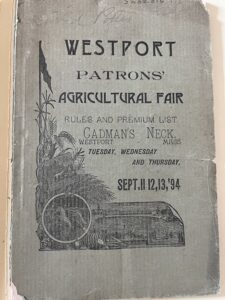
What happened during the event:
Headline “The great show at Cadmans Neck opens, Fun for the millions”
The fair was held over three days in September. They charged an admission fee of 25 cents.
More than 7000 people attended the event! According to the newspaper reports: “most drove to the fair, but the stable could only accommodate 40 horses, so the trees in the grove were utilized, every one as a hitching post.”
“A man in blue jeans was stationed at the outer gate and turned carriages into the vacant lots on either side of the entrance.”
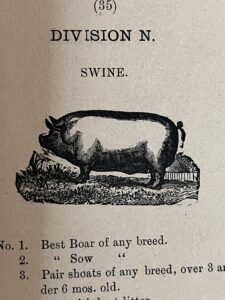
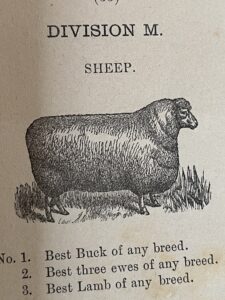
Highlights of the fair included:
- Best fat cow
- Cow giving largest quantity of milk at one milking
- Best ewes of any breed
- Best boar
- Incubator hatching largest percent of total number of eggs while on exhibition
In the exhibition hall:
- White bread, brown bread, eggs, cheese, homemade wines and preserves and canned fruit, and coconut cake.
- Fresh fruit – 18 varieties of apples, among them some extra fine pippins
- Fine arts: watercolor paintings, crazy quilt
- Flower show, featuring a mammoth geranium
- An exhibition of fancy work that “showed to good advantage the handiwork of the ladies of the town.”
- An exhibition of old-fashioned articles including a pair of corsets more than 100 years old.
- George E. Tripp of Westport exhibited seven varieties of apples and pears.
- A display of carrots, grapes, plums, peaches, and melons.
- “William H. Potter has on exhibition a duck 27 years old.”

Governor Russell
Governor Russell, who served as Massachusetts’ 37th governor from 1891 to 1894, attended the fair and delivered a speech. He was the state’s second youngest chief executive and passed away at the age of 39.
He traveled to Cadmans Neck on horseback with an escort of prominent citizens. The newspaper criticized the Fair’s management, describing them as “avaricious” for collecting a quarter from the staff, aldermen and other invited guests.
“At noon with 4,000 people present, a mammoth clam dinner was served but not many persons found anything to eat, the management was quite unprepared for so large a crowd. 100s were turned away while those who secured tickets received little else but the pasteboards for their money.”
The clambake was followed by more contests classed in the fair booklet as the “Department of sports and pastimes.”
- A fish cleaning match, contestants were required to clean and dress four tautog. Newspaper reports recount: “their jackets came off so quickly that some of the spectators swore the fish jumped out of their skins.”
- “The plowing match prize awarded to Henry M. Plummer without a contest, he being the only contender.”
- A 100-yard dash with a prize of a gold fountain pen.
- A nail driving contest (contestants to provide their own hammers)
- 300 yard swimming race
- Chicken picking contest
- One mile bicycle race
- Catching greased pig
- Climbing greased pole
- Tub race
- Potato digging match
- Pie eating contest
The Musical Exchange band provided entertainment.
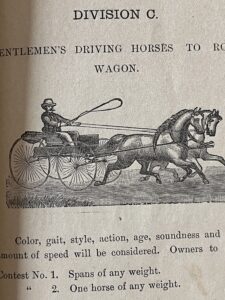
The highlight of the fair seems to have been the race track.
Cadmans Neck boasted the only quarter mile track on any fairground in New England. On a bluff at the extreme southeast end of Cadmans Neck, there was an oblong track a quarter mile long, 40 feet wide, with a stand for judges, and a grand stand – a rather primitive structure from which a complete view could be had of the track. It was the site of trotting races and pacing races.
But all did not go well – three sulkies were demolished on the track and one man nearly broke his neck.
The Aftermath
A few days after the fair, with $863 in the treasury, the association voted not to hold a fair the following year. They decided to sell everything at a public auction, dismantling the south building, packing up the lumber for sale. Other buildings remained standing.
The partnership between Dartmouth and Westport Granges was dissolved.
As suggested by the newspaper accounts, the fair did not go as planned, attracting too large a crowd and, at times, seemed on the edge of getting out of control. It was fortunate that there were not more accidents and injuries
But all was not lost! In 1894, the fair returned but without Dartmouth. The details of the Westport Patrons Agricultural Fair of 1894 are yet to be chronicled.
A few extra tidbits found during research for this topic:
May 1894
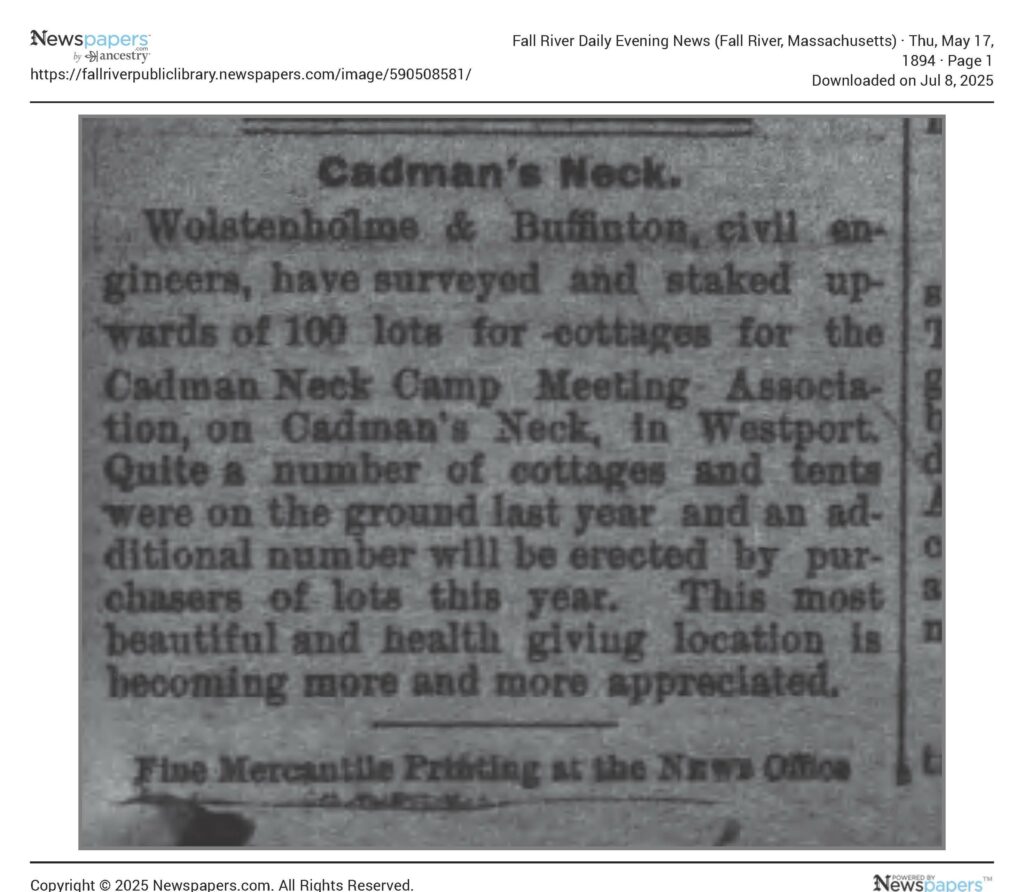
Wolstenholme and Buffinton, civil engineers have surveyed and staked upwards of 100 lots for cottages for the camp meeting association. Quite a number of cottages and tents were on the ground last year. This is the most beautiful and health-giving location.
July 1894

Tommy Roberts will tell the story of his conversion at the meetings at Cadmans Neck. He was a prize fighter in England, and afterwards rode some of the most famous horses as a jockey. He will bring his cornet, and will sing several duets with Miss Greenwood.
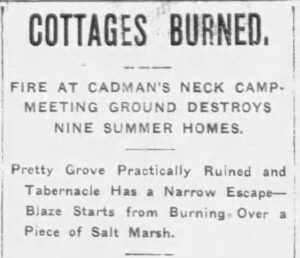
April 1905 Cottages Burned
Nine of the twenty cottages were destroyed by a fire. The flames spread over the ground to within a few feet of the Tabernacle. The fire was started by some farmers burning a piece of salt marsh, fanned by high winds, the blaze spread through the covering of oak leaves to the grove like a race horse. The few residents had very little with which to fight the fire other than buckets. Total loss amounted to $2000, the cottages being valued at about $200 each, only a few of them were insured. Those who lost cottages included:
Dr Parris
J.M Shorrock
Nancy Poole
Mrs Julius Gifford
Caron of New Bedford
Rev. Perry of Lakeville
July 1912 Gilbert Wordell celebrated his 89th birthday at his summer home on Cadmans Neck, hale and hearty despite his advanced years. Although a farmer by vocation, he is much sought after as a builder and has built most of the cottages at Cadmans Neck. A prominent churchman, and a deacon, he has been the prime mover for years at the Cadmans Neck camp meeting.
Cadmans Neck Baseball team
 During the 1920s, Cadmans Neck formed its own baseball team. Team players: J. Weeks, H. Davis, W. Darling, Lynch, Coffey, Richards, Pickering, Tavas
During the 1920s, Cadmans Neck formed its own baseball team. Team players: J. Weeks, H. Davis, W. Darling, Lynch, Coffey, Richards, Pickering, Tavas
It played against various local teams, such as South Westport. According to the newspaper: “One such game resembled a comedy of errors, until the latter part of the game when teams began to pull off some clever plays. J. Weeks on the mound for the summer colonists proved too much for the town folks with the result that very little batting took place.”
Who was Henry Plummer
https://waterfrontleague.org/news/whale-moment-meet-the-plummers/
In 1892, Henry established Potomska Farm on Potomska Road in Dartmouth. It was one of the first farms to begin artificial poultry raising to mass produce poultry and eggs for retail and wholesale distribution. Henry also made a name for himself in the flour industry. In 1897, Henry bought out the Denison Plummer Company which was a combination of the New Bedford Flour Mill Company and Denison & Company (Denison Brothers).
